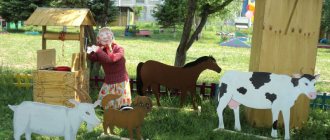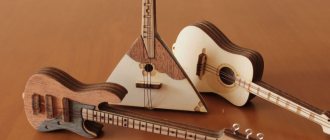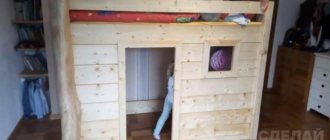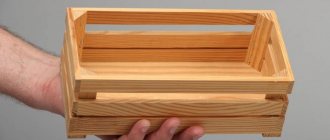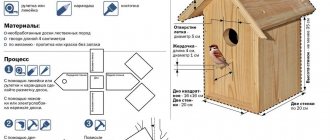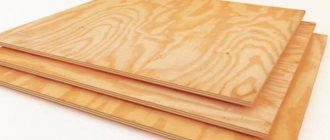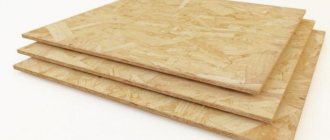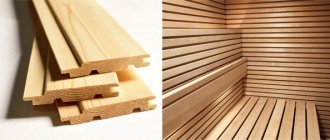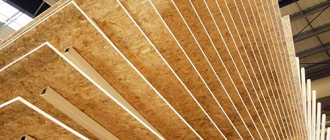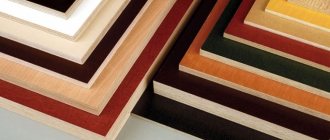Construction of houses is a responsible matter for every family. You need to think in advance about what to build a house from; the construction time and the costs of building housing depend on this. Today we will not discuss construction with ordinary bricks; we will consider the three most popular types of building materials after brick, log house, blocks and vulture panels.
Application
Plywood has strength, durability, lightness and rigidity. It also has increased resistance to deformation, bending and splitting. In almost every hardware store it can be purchased at a fairly affordable price. Plywood, given its environmental friendliness, is used not only in traditional construction projects, but also in shipbuilding, creating aquariums and tanks.
The use of this material to create furniture and partitions is widespread. Its high strength allows it to be used in combination with ordinary wood or other framing materials. This versatility and environmental friendliness of interior plywood has led to it becoming a favorite among designers and interior decorators.
When purchasing this material, please note that there are different grades. The usual grading system uses numbers from 1 to 4, as well as the letter E - an elite grade that does not allow any defects. Grade 1 - best quality, virtually no defects, very well polished. Grade 4 is extremely low quality, usually containing the maximum permissible number of defects. Double marking. The first number or letter refers to the outside, and the second to the inside. Each variety has its own area of application.
Advantages of plywood:
- Quite resistant to unfavorable climatic conditions.
- Less likely to warp or crack than solid wood.
- It has good appearance and high strength at a lower price.
Cons of plywood:
- The veneer can chip, exposing the less expensive wood underneath.
- The damage is difficult to repair.
- Some types of plywood use glue and formaldehyde.
DIY furniture.
Materials: chipboard, fiberboard, MDF. What it is? What are the differences? A short review of materials.
Chipboard (chipboard)
Oh, who among us doesn’t know chipboard! Who hasn’t said in disappointment: “Well, this is deespe...” But let’s get to the point. Chipboard is made from sawdust and shavings impregnated with a binder, namely formaldehyde resins. This is the most common material for cabinet furniture, interior design, construction (roofs, partitions, etc.).
Pros: water resistance, strength, ease of processing. Chipboard “holds” nails and screws holding the structure together well. Another advantage of chipboard is its low price. That is why chipboard is the most widely used material for economy class furniture; Most office furniture is made from chipboard.
For kitchens and baths, a special type of chipboard is used - with increased moisture resistance.
Cons: the presence of those very formaldehyde resins that hold wood particles together. The fact is that chipboard releases a certain amount of formaldehyde into the air - not the most healthy product, it should be noted. But it's not all that scary. There are two types of chipboard: E1 and E2. E1 is more environmentally friendly; its formaldehyde emission rate is noticeably lower. But E2 is prohibited from being used in the production of children's furniture: draw your own conclusions. The most environmentally friendly are chipboards made in Austria and Germany.
Chipboard is a very hard material that does not allow fine processing (deep milling, all kinds of shaped parts).
Classification and designations of chipboard.
Particleboards are made from different types of wood raw materials and non-wood particles using different types of binders, in different ways and for different purposes.
Let's look at the classification and types of slabs using their markings as an example: P-A, 1, M, Sh, E1, 3500x1750x16, GOST 10632-89
.
The standards existing in Russia distinguish two grades of chipboard: P-A and P-B. These brands differ in their physical and mechanical characteristics. Grade P-A is of higher quality and has better bending and tensile strength and lower percentages of swelling, warping and surface roughness than grade P-B.
There are slabs of 1st grade, 2nd grade, as well as non-grade slabs, which are usually used for construction purposes.
The main differences between grades 1 and 2:
- No protrusions or depressions, resin or paraffin stains are allowed on the first grade slab;
- On a first-grade slab, chipping of edges and chipping of corners is not allowed (with the exception of single chips (chipping) up to 3 mm and extending along the edge up to 15 mm); on a second-grade slab, chipping of the edges is allowed within the limits of deviations along the length (width) of the slab;
- there may be grinding defects on the surface of the second grade slab (no more than 10% of the area);
- On the surface of a slab of the second grade, inclusions of bark and large fractions of chips may be present to a greater extent compared to the first grade.
The third position (in our example: M) is the type of outer layer of chipboard.
Based on the type of outer layer, a distinction is made between slabs with a fine-textured surface (M), a regular surface, and slabs with outer layers of coarse chips. The latter are used only for construction purposes and for cladding with natural veneer.
The fourth position (in our example: Ш) is surface treatment of chipboard.
The slabs can be polished (Ш) or unpolished.
The fifth position (in our example: E1) is the formaldehyde emission class in chipboard.
The emission class shows the permissible content of free formaldehyde in 100 grams of a completely dry board according to GOST 10632-89. There are two emission classes: E1 (up to 10 mg), E2 (10-30 mg). Manufacturing boards with a high content of formaldehyde is unacceptable.
The sixth position (in our example: 3500x1750x16) is the dimensions of the chipboard in mm.
The seventh position (in our example: GOST 10632-89) is the GOST number on the chipboard.
For cladding with paper-resin films (lamination and laminating), sanded chipboard of grade P-A, first (rarely second) grade with a fine-textured surface and formaldehyde emission E-1 (worse E-2) is used.
For the production of children's furniture, only class E-1 board should be used.
Continuing the topic of chipboard classification, mention should be made of the following additional properties that can be imparted to the boards:
Water resistance.
The slabs come in standard and increased (letter “B” in the marking) water resistance. In the vast majority of cases, slabs with ordinary water resistance are used. It is advisable to use slabs of increased water resistance for the manufacture of countertops for kitchens, furniture for bathrooms, as well as for special construction purposes.
When making waterproof chipboard, before pressing, a special paraffin emulsion or molten paraffin is introduced into the chip mass. An indicator of water resistance is swelling in thickness (over 24 hours, upper limit):
- regular chipboard, grade P-A - 22%,
- regular chipboard, grade P-B - 33%,
- waterproof chipboard - no more than 15%.
Fire resistance.
To make chipboard fire-resistant, special substances are introduced into its composition - fire retardants. Currently, there is no specialized production of fire-resistant boards in Russia.
Laminated chipboard
This is a chipboard lined with a film based on thermosetting polymers (paper-resin films). How is the film made? At first it looks like regular paper. The most famous manufacturer of such paper is Interprint; There are a huge number of shades and textures of paper, so you can’t complain about the monotonous appearance of laminated chipboard.
After impregnation with melamine resin, the paper becomes hard and brittle; then, using pressing, the film is “tightly” connected to the surface of the chipboard.
Pros: variety of colors and textures, imitation of the texture of natural wood, resistance to all kinds of mechanical damage, resistance to thermal effects (in other words, to hot coffee pots and frying pans).
Disadvantage: the same as with chipboard: the impossibility of fine processing.
Production
In the plywood manufacturing process, individual layers of veneer are first obtained by rotary cutting of wood. To do this, the logs are rotated around the longitudinal axis, and the cutter cleans it (the thickness of each layer is usually less than 2.5 mm). Next, the glue is applied to the layers using a special machine. It helps in achieving uniform distribution of the glue. In this case, the layers are superimposed on each other and pressed tightly using a hot pressing machine.
The high temperature and pressure created by this technique ensures strong adhesion of the layers. Their number in each sheet of plywood can vary from 3 to 13. The thickness of the sheets from different manufacturers ranges from 3 mm to 30 mm. Standard sheet sizes are 1220 by 2440 mm. There are other sizes that are more convenient to use. It all depends on the manufacturer. The user can cut or sand these sheets according to the required specifications. There are several main types of glue used for manufacturing. The type of plywood, composition, and environmental friendliness should be studied before purchasing.
Marking
For a complete qualitative assessment, a marking is applied to the plywood sheet or tag, by which you can find out its main characteristics.
For example, the inscription “pine plywood FSF 1/2 E1 Sh2 1500x1500x9 GOST 3916.2-96” means that the plywood is made of pine veneer glued with formaldehyde resin, with surfaces of the 1st and 2nd grade (front and back sides), first class phenol emissions, with double-sided grinding, thickness 9 mm, size 1500x1500 mm, produced according to the specified GOST.
If you notice an error, a non-working video or link, please select a piece of text and press Ctrl+Enter .
0
FSF
Phenol-formaldehyde adhesive is a type of synthetic or man-made polymer that is produced by chemical reactions of phenol and formaldehyde.
Phenolic resins provide a stronger bond than urea-based substances. Hence, they are used in making stronger and better quality plywood. The moisture resistance of this material is very high. The marking is as follows: FSF. The main and very significant disadvantage of formaldehyde resins is the harmful substances included in their composition. Their use is unacceptable for furniture production and residential premises.
Blocks
There are many different types of blocks. The most common foam blocks and gas blocks. Gas blocks and foam blocks have gained great popularity in the construction of private houses in a short time. They have a number of advantages, good heat resistance, sound insulation, lightweight in size compared to other materials, due to this, lower costs for the foundation. Disadvantages: quite fragile, they need to be lined as they quickly absorb moisture due to their porous structure. The cost of a house made of foam blocks will be 11,000 - 20,000 rubles. m2.
FC and FBA
There are no harmful substances in the composition of urea and albumin casein glue. As a result, the plywood in which they are used can be used in the finishing of any buildings, even kindergartens. It is also used in furniture. The main drawback is that this material is not waterproof. In FC plywood, environmental friendliness is ensured by the safe urea adhesive used in its production. FBA plywood contains albinocasein glue.
Types of plywood by type of sanding
In addition, plywood is divided into several types according to the degree of sanding:
- Ш-1 - plywood, sanded on one side only.
- Ш-2 – plywood, sanded on both sides.
- NS - not polished.
Types of sanding plywood.
Judging by how popular plywood is these days, we can safely say that it is an absolutely irreplaceable material that can be successfully used in performing a large variety of jobs of all kinds.
FB
Sometimes moisture resistance is a priority requirement. In these cases, marine plywood is used. In the production of this material, the best brands of moisture-resistant bakelite glue are used. Such plywood is most often marked as follows: FB. It has two top quality surfaces but a limited selection of hardwoods that are suitable for marine use. As a rule, birch is used. Marine plywood is much more difficult to find. It costs more than other varieties of this material. Depending on the gluing method, there are subtypes of plywood:
- FBS – impregnated with alcohol-soluble glue and has increased moisture resistance.
- FBV – is impregnated with water-soluble glue and has increased strength.
What is the difference between plywood and chipboard?
Both materials contain wood. But plywood is called more environmentally friendly. And that's why:
Plywood is layers of veneer firmly glued together. Essentially, the material consists of the thinnest sheets of inexpensive wood and synthetic layers.
- And chipboard is a chipboard made from compressed small shavings. In this case, much more glue is used.
Both of these materials are used as a rough substrate for laminate, parquet, linoleum and other floor coverings. Using chipboard or plywood, the surface is leveled and insulated. The result is a higher quality, stronger and more durable coating.
Environmental friendliness of plywood and harm to health
Materials containing formaldehyde resins, according to European standards, are divided into 3 categories (E0, E1, E3). The number shows the level of harmful substances. The safest plywood is E0.
The use of veneer expands the possibilities of using natural wood species. Veneer is an absolutely natural material. However, the production of plywood requires significantly less wood compared to solid wood products. This reduces the number of trees cut down. Veneer is an environmentally friendly alternative to hardwood.
There are health concerns about the adhesives used in wood production because they contain harmful substances. This especially applies to phenol and formaldehyde. Not so long ago they were considered safe for health, but now the opinion of experts has changed dramatically. Research shows that these substances negatively affect people's health.
Allergic reactions, headaches, breathing problems and all kinds of inflammation are some of the possible problems caused by these substances. Carcinogenic properties are also attributed to phenol-formaldehyde compounds. The proportion of harmful substances in modern plywood is small, but they are present. This fact should not be ignored.
What is known about phenol
Phenol is a derivative of benzene. This is a toxic substance for humans, which, when ingested, affects the visual center and central nervous system. The lethal dose for humans is 5-10 g, and the MPC is 1 mg/m3 of air. Does this mean that phenol-containing plywood is dangerous?
Only waterproof types of plywood contain phenol - FSF, FOF, FBV and FBS. But it makes up only 11% of the total mass of resin used to glue the veneer. Everything else is formaldehyde. In this regard, phenol does not have a significant effect on human health. But as a precaution, materials containing this substance are not recommended for interior decoration.
Reducing exposure
Modern science does not stand still. Methods are being developed to help increase the environmental friendliness of plywood. One solution is to create a modified adhesive based on phenol-formaldehyde resin. It contains wheat flour and chalk, which increase the elasticity and viscosity of the adhesive joint. Moreover, they are natural products. This improves toxicity indicators and promotes energy saving in production.
There is also currently a concerted effort by manufacturers in different countries to develop completely environmentally friendly adhesives to make plywood a completely safe material for people and the environment. An alternative may be adhesives such as soy-based amino acids. They do not contain pollutants that cause gases. Safety plywood is also produced with an agrofibre or wheat straw core, which further makes it environmentally compliant.
Russia is a country with a fairly developed woodworking industry. Our plywood production has long traditions and a high level of accumulated knowledge. Rich forest resources and competitive production provide good opportunities to invest in new technologies, resulting in more sustainable plywood.
Plywood or chipboard: advantages and disadvantages of materials
What will be the best choice - chipboard or plywood - depends on what properties of coatings you need.
For example, it is impossible to unequivocally answer the question of what is stronger – plywood or chipboard. Plywood is better able to withstand direct mechanical impacts and is resistant to abrasion. But chipboard begins to deteriorate over time. In addition, nails, screws and self-tapping screws do not adhere very well to chipboards - the material crumbles. But chipboard is considered stronger in bending.
When it comes to moisture resistance, plywood wins here. Even if chipboard is impregnated with a special solution, it will still be more vulnerable in conditions of high humidity.
Both plywood and chipboard do not tolerate moisture well. In rooms with high humidity, mold often forms on them. Materials are susceptible to rotting. Therefore, before installation they should be treated with an antiseptic. And if the humidity is very high, it is better to use OSB for the subfloor.
Chipboard has the best sound and heat insulation properties. If this is an important parameter for your subfloor, it is better to choose particle board.
What is more harmful: FC or FSF
Many people are interested in which plywood is less harmful: FC or FSF. To answer this question, let's look at the information discussed above. Based on this, we draw three conclusions:
- The harm of FC plywood is less, since it contains only one of the dangerous components - formaldehyde.
- There are more harmful emissions from FSF plywood, since it contains both formaldehyde and phenol.
- The harm from FSF plywood is higher, since it belongs to the second emission class - E2.
That is why it is recommended to use only FC plywood in interior spaces. FSF and FOF sheets are intended for external use. This is due to the fact that in open space toxic compounds immediately evaporate and cannot cause harm to humans. Using plywood according to the recommendations, you will not harm yourself or your loved ones.
Installation of plywood on the floor
- Elite grade - plywood without significant defects. Small deviations in the structure of wood, which are random in nature, are allowed. The presence of knots (fused, healthy, falling out), wormholes and brown veins is unacceptable. Elite grade plywood is varnished and used to make laminated plywood.
- 1st grade – has virtually no flaws, can be varnished. This type of plywood may have fused or falling out knots and holes with a diameter of no more than 5-6 mm, and brown veins.
- Grade 2 – has more pronounced disadvantages. Fused knots, 6 mm holes, which are closed with veneer inserts. Grade 2 is not covered with varnish, only with paint and other finishing materials.
- 3rd grade - no more than 10 pieces are allowed on the surface of one sheet of third grade plywood. wormholes with a diameter of 6 mm. The number of fused and healthy knots is not limited.
- Grade 4 – has an unlimited number of visible defects, knots, veins and holes of different diameters. This grade guarantees only high-quality gluing of layers.
How to treat the surface → Room decoration → How to choose the right paint → Surface treatment technologies → Leveling and finishing the walls → Selecting and applying a primer → Removal from the surface → Stretch ceilings and technologies → Reviews and testimonials
Alternative use of these building materials
If you are not fixated on purchasing any of the above-mentioned plywood, then in this case, the most appropriate option would be to purchase sheets marked FB. This plywood combines the advantages of using both of these materials. It has the opportunity to boast of having really high characteristics, which are determined by the peculiarities of its production. This veneer is impregnated with a special bakelite varnish, which ensures truly impressive physical and technical characteristics!
The concept of “plywood” is a collective term that combines sheets glued together from three or more layers of wood veneer. Wood fibers are usually perpendicular, which allows plywood to hold its shape and resist dynamic loads.
Currently, FC
and
FSF
. However, disputes between finishers about the quality of products and their environmental safety continue. Let's try to understand this issue.
Negative effects of plywood on the human body
- If you plan to install adjustable floors, then logs will not be required; you only need special fasteners installed under the plywood.
- It is possible to lay plywood sheets on joists or floor beams. In this case, you need to understand which plywood is best to use for floor joists. You will need slabs of at least 12 mm and a finished frame base. This kind of floor will require the most time to implement; it is necessary when you need to insulate the floor or raise it to the required height. The use of adjustable joists eliminates differences in floor heights. This is why adjustable joists are often used by builders.
